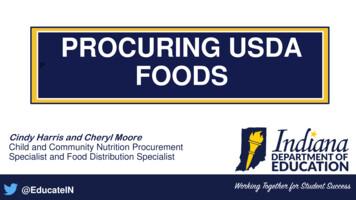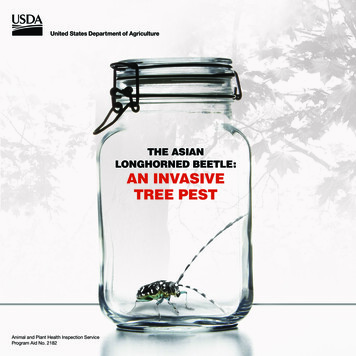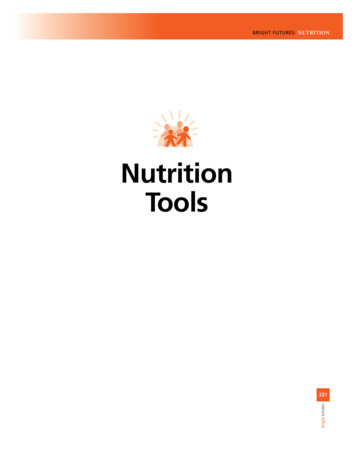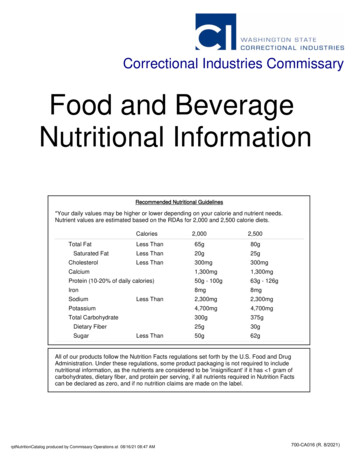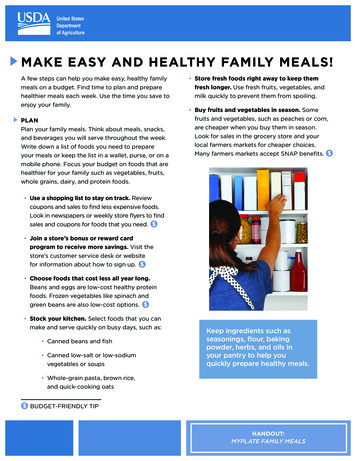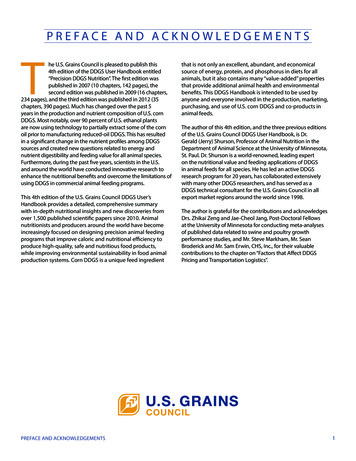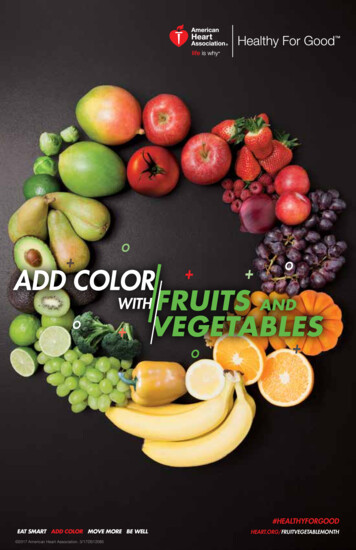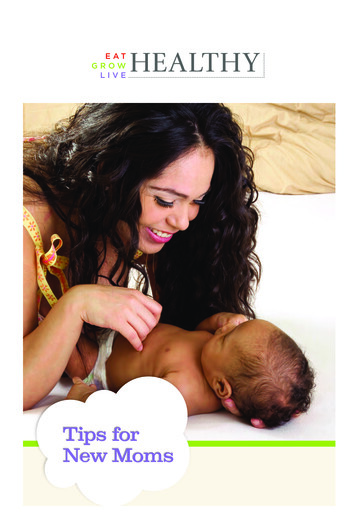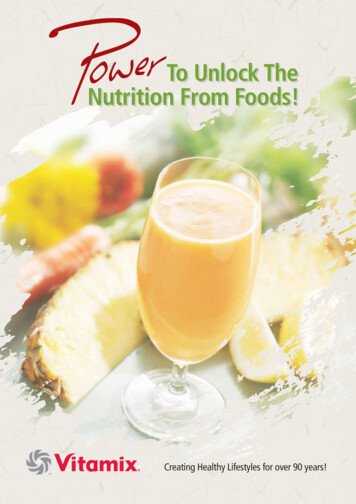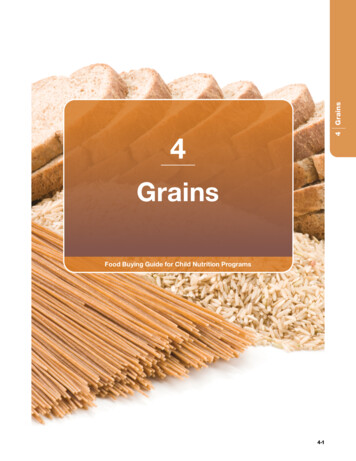
Transcription
4 Grains4GrainsFood Buying Guide for Child Nutrition Programs4-1
4 GrainsGrains Component for the Child Nutrition ProgramsAll reimbursable meals offered in the National School Lunch Program(NSLP), School Breakfast Program (SBP), Child and Adult CareFood Program (CACFP), and Summer Food Service Program (SFSP)must include a grains food product. A reimbursable snack in theCACFP, SFSP, or the NSLP Afterschool Snack Service must include acreditable grain.FNS meal pattern regulations establish the minimum serving size(s)of grains required for breakfasts, lunches, suppers, and snacks.Meal pattern charts for each of the Child Nutrition Programs are onpages I-7 through I-17. This section pertains to grains requirementsin the NSLP, SBP, and CACFP. Please refer to Appendix E for grainsrequirements for the SFSP and NSLP Afterschool Snack Service.4-2Food Buying Guide for Child Nutrition Programs
Definitions1BranBran is the seed husk or outer coating of cereal grains such as wheat, rye, andoats. The bran can be mechanically removed from the flour or meal by siftingor bolting. Bran can be used to meet the enriched grains requirements in ChildNutrition Programs.CreditablegrainsCreditable grains represent all of the grain ingredients in a product that arecreditable toward the grains component; they include whole-grain flour, wholegrain meal, corn masa, masa harina, hominy, enriched flour, enriched meal,bran, germ, or be included in an enriched product such as, enriched bread orin a fortified cereal.EnrichedEnriched means that the product conforms to the U.S. Food and DrugAdministration’s (FDA) Standard of Identity for enrichment (21 CFR Section 137).The terms “enriched,” “fortified,” or similar terms indicate the addition of oneor more vitamins or minerals or protein to a food.FlourFlour is the product derived by finely grinding and bolting (sifting) wheat orother grains. Flour may be made from all grains (wheat, rye, corn, etc.).GermGerm is the vitamin-rich embryo of the grain kernel. The germ can beseparated before milling for use as a cereal or food supplement. Germ can beused to meet the enriched grains requirements in Child Nutrition Programs.NixtamalizationNixtamalization is a process in which dried corn is soaked and cooked in analkaline (slaked lime) solution. This process increases the bioavailability ofcertain nutrients. Nixtamalized corn is used to make hominy, corn masa (doughfrom masa harina), masa harina (corn flour), and certain types of cornmeal.These ingredients are considered whole grain when evaluating products forCNP meal requirements. If the ingredient statement indicates the corn istreated with lime (for example, “ground corn with trace of lime” or “ground corntreated with lime”), then the corn is nixtamalized.OunceequivalentsOunce equivalents designates the contribution a given serving size makestoward the grains component. One ounce equivalent provides sixteen grams ofcredible grains.Primary grainingredientPrimary grain ingredient is the first grain ingredient listed in the ingredientstatement.Whole grainWhole grain contains all parts of the grain kernel which includes the bran, germand endosperm.Wholegrain-rich(WGR)1Whole grain-rich (WGR) is the term designated by FNS to indicate that thegrains components in a product are at least 50 percent whole grain, withthe remaining grains being enriched. This term only refers to FNS criteria formeeting the grains requirements for the NSLP, SBP, and CACFP. The termis not found on product labels and should not be confused with the FDA wholegrain health claim.Please refer to Appendix E for grains/breads requirements in the SFSP and NSLP Afterschool Snack Service.Grains4-3
4 GrainsExamples of Foods That Are Creditable Toward the Grains ComponentThe following types of ingredients are considered creditable grains inChild Nutrition Programs: whole grains (i.e. whole wheat, whole-wheat meal/flour, brown rice,rolled oats, whole corn)enriched grains (i.e. enriched wheat meal/flour, enriched rice)bran or germ can be used to meet the enriched grains requirementsin Child Nutrition ProgramsNote: nixtamalized corn, (i.e., corn treated with lime), such ashominy, corn masa, and masa harina are considered whole grainwhen evaluating products for meal requirements. (Please refer tothe “Definitions” section for more information on nixtamalization).These ingredients are processed in a way that increases thebioavailability of certain nutrients so they have a nutritional profilesimilar to whole corn.Foods that contribute to the grains requirement in all Child Nutrition Programs include thefollowing items when made from above specified ingredients but are not limited to:Breads, biscuits, bagels, rolls, tortillas, crackers, cereal grains (cooked) such as rice,bulgur, oatmeal, corn grits, hominy grits, wheat berries, or couscous Must be made from creditable grains: whole-grain flour, whole-grain meal, corn masa,masa harina, hominy, enriched flour, enriched meal, bran, germ, or included in an enrichedproduct such as, enriched bread or in a fortified cereal.Ready-to-eat (RTE) breakfast cereals If the product includes enriched ingredients, or the product itself is labeled as “Enriched,”it must meet the Food and Drug Administration’s Standards of Identity for enrichment(12 CFR Section 137).In the NSLP/SBP, RTE cereals that list a whole grain as the first ingredient must be fortified.If the cereal is 100 percent whole grain, fortification is not required.All breakfast cereals served in the CACFP must contain no more than 6 grams of sugar perdry ounce.Cereals or bread products that are used as an ingredient in another menu item such ascrispy rice treats, cereal bars, oatmeal cookies, or breading on fish or poultry Must be made from creditable grains: whole-grain flour, whole-grain meal, corn masa,masa harina, hominy, enriched flour, enriched meal, bran, germ, or included in an enrichedproduct such as, enriched bread or in a fortified cereal.See above requirements for RTE cereals in the NSLP, SBP, and CACFP.Macaroni, pasta, noodle products (cooked) 4-4Must be made from credible grains: whole-grain flour, whole-grain meal, corn masa, masaharina, hominy, enriched flour, enriched meal, bran, germ, or included in an enrichedproduct such as, enriched bread or in a fortified cereal.Food Buying Guide for Child Nutrition Programs
The NSLP and SFSP regulations allow enriched macaroni products that have been fortifiedwith protein to be counted toward either the grains or meats/meat alternates requirements,but not toward both meal components simultaneously. In the NSLP, these products may be counted toward meeting part of the meats/meatalternates requirement only. However, enriched macaroni products that have beenfortified with protein cannot count toward the grains or meats/meat alternates mealcomponents simultaneously. The CACFP regulations allow enriched macaroni products that have been fortified withprotein to be counted toward the grains requirement only. Pasta products made with bean flours do not count toward the grains requirement.Please see Appendix C for more information on products made with bean flour and howthey may contribute to Child Nutrition Program meal pattern requirements.Sweet food products such as toaster pastries, coffee cake, doughnuts, sweet rolls, piecrusts, cookies, cakes, etc. Must be made from creditable grains: whole-grain flour, whole-grain meal, corn masa,masa harina, hominy, enriched flour, enriched meal, bran, germ, or included in an enrichedproduct such as enriched bread or in a fortified cereal.No more than 2.0 oz eq grains served per week in the NSLP may be in the form ofa grain-based dessert.Grain-based desserts do not count toward the grains component in the CACFP mealpattern requirements.Non-sweet snack food products such as hard pretzels, hard bread sticks,and tortilla chips Must be made from creditable grains: whole-grain flour, whole-grain meal, corn masa,masa harina, hominy, enriched flour, enriched meal, bran, germ, or included in an enrichedproduct such as enriched bread or in a fortified cereal.See pages 4-6 through 4-7 for more information on grains requirements in each CN program. At least half of the grains offered weekly in the NSLP (7 CFR 210.10(c)(2)(iv)(B)) and the SBP (7 CFR220.8(c)(2)(iv)(B)) must be whole grain-rich, and the other grain items offered must be enriched.See pages 4-7 through 4-9 for more information on the criteria. (Please note: State agencies havethe discretion to set stricter requirements than the minimum nutrition standards for school meals.For additional guidance, please contact your State agency.) For the CACFP, at least one serving of grains per day must be whole grain-rich.Grains4-5
4 GrainsCriteria for Determining Acceptable Grain ItemsThe following criteria are to be used as a basis for crediting items to meet the grainsrequirement in the Child Nutrition Programs. Creditable grain items are made from grains that are whole-grain flour, whole-grain meal,corn masa, masa harina, hominy, enriched flour, enriched meal, bran, germ, or be anenriched product, such as enriched bread, or a fortified cereal.Some enriched grain products that are being blended with whole-grain ingredients mustmeet the Food and Drug Administration’s Standards of Identity (21 CFR Part 136, Part 137,Part 139) for enriched bread, macaroni and noodle products, rice, or cornmeal.School Meal Programs Ounce equivalents (oz eq) are used to determine the amount of creditable grains.One-quarter ounce equivalent (0.25 oz eq) is the smallest amount allowable to be creditedtoward the grains requirement as specified in program regulations.At least half of the weekly grains offered must meet the whole grain-rich criteria,meaning they are: 100 percent whole grain; or contain a blend of whole-grain ingredients and enrichedgrain ingredients (whole-grain meal and/or whole-grain flour blended with enriched mealand/or enriched flour), of which at least 50 percent is whole grain. Bran and germ can be used to meet the enriched grains requirements.Note: Nixtamalized corn (i.e., corn treated with lime), such as hominy, corn masa, and masa harinaare considered whole grain when evaluating products for meal requirements. See page 4-3 for moreinformation on nixtamalization.Please note: State agencies have the discretion to set stricter requirements than the minimumnutrition standards for school meals. For additional guidance, please contact your State agency. Up to half of the grain items offered weekly can be made from grains that are enrichedmeal and/or flour. Bran and germ can be used to meet the enriched grains requirements.Please refer to Appendix E for grains requirements in the SFSP and NSLP Afterschool Snack Service. Up to 2.0 oz eq grains per week may be credited in the form of a grain-based dessert.CACFP and Preschool 4-6Ounce equivalents (oz eq) are used to determine the amount of creditable grains (startingOctober 1, 2021). Prior to October 1, 2021, the current criteria forgrains/breads servings may be used. See Appendix E for more information.One-quarter ounce equivalent (0.25 oz eq) is the smallest amount allowable to be creditedtoward the grains requirement as specified in program regulations.Grain items must be made from grains that arewhole-grain flour, whole-grain meal, corn masa, masa harina, hominy, enriched flour,enriched meal, bran, germ, or be an enriched product such as enriched bread ora fortified cereal.At least one serving of grains per day must be whole grain-rich.Grain-based desserts cannot be credited toward the grains component.Breakfast cereals must contain no more than 6 grams of sugar per dry ounce.Food Buying Guide for Child Nutrition Programs
SFSP and NSLP Afterschool Snack Service(except Preschool) Grain items are credited in servings. See programguidance and Appendix E for further information.One-quarter serving is the smallest amount allowableto be credited toward the grains requirement asspecified in program regulations.Grain items must be made from grains that arewhole-grain flour, whole-grain meal, corn masa,masa harina, hominy, enriched flour, enriched meal,bran, germ, or be an enriched product, such asenriched bread, or a fortified cereal.What Foods Meet theWhole Grain-Rich Criteria?Please note that while the SFSP and NSLPAfterschool Snack Service are not requiredto serve grain items that meet the wholegrain-rich criteria; however, regularly offeringitems that meet these standards will helpchildren develop healthy eating habits.Also, the SFSP and NSLP Afterschool SnackService are not required to credit grainsusing ounce equivalents. However, ounceequivalents contain a slightly higher amountof creditable grains than grains servings.Therefore, ounce equivalents may be usedto calculate grains servings in the SFSP andNSLP Afterschool Snack Service if the ChildNutrition program operator wishes to do so.See Appendix E for more, information.The NSLP, SBP and CACFP meal patterns require specific amounts of grain foods that meetthe whole grain-rich criteria to be served.Any one of the following methods can be used to evaluate if a grain product meets the wholegrain-rich criteria:A. Use Exhibit A: Grain Requirements for Child Nutrition Programs: For grain items in Groups A – G of Exhibit A, the whole-grain content per 1 ounceequivalent (oz eq) must be at least 8 grams out of the standard 16 grams. The remaininggrains must be enriched.For grain items in Group H of Exhibit A, the volumes or weights listed in the chartcan be used to meet grains requirements. For example, a ½ cup of cooked brown riceor enriched rice is equal to 1.0 oz eq of whole grain or enriched grain, respectively.As another example, if dry pasta includes a blend of whole-grain flour and enrichedflour, the whole-grain content must be at least 14 grams of whole-grain flour out of thestandard 28 grams of creditable grains per oz eq. The remaining 14 grams of flour mustbe enriched. This information may be determined from information provided on theproduct packaging or by the manufacturer, if available. If any non-whole grains (refinedgrains) are included, they must be enriched. Ready-to-eat (RTE) breakfast cereals in Group I of Exhibit A must list a whole grain asthe primary ingredient and the cereal must be fortified. RTE breakfast cereals that are 100percent whole grain are not required to be fortified. However, any non-creditable grainsmust be restricted to insignificant levels.Please find Exhibit A online blesFBG/ExhibitA.pdf.B. Use the FDA-Approved Whole Grain Health ClaimThe product includes one of the following FDA-approved whole grain health claims on itspackaging and any refined grains in the product are enriched:“Diets rich in whole grain foods and other plant foods and low in total fat, saturated fat,and cholesterol, may reduce the risk of heart disease and some cancers.” OR “Diets rich inGrains4-7
4 Grainswhole grain foods and other plant foods, and low in saturated fat and cholesterol, may helpreduce the risk of heart disease.”C. Use the Ingredient Statement (List)Whole grains are the primary ingredient by weight, with the exception of water. Specifically:I. Non-mixed dishes (e.g., breads, cereals): A whole grain is the first ingredient in the list(ingredients are listed in descending order of predominance by weight). Any other grainsmust be enriched. When a whole grain is listed first and there are two or more enrichedgrains that follow, additional information is needed from the manufacturer in the form ofa product formulation statement. The document will need to indicate that the whole grainweighs equal to or more than the enriched grains in the product.Even if a whole grain is not listed as the first ingredient, if there are multiple whole-grainingredients, the combined weight of those whole grains may be more than the weightof the other ingredients. These products could meet the whole grain-rich criteria withproper manufacturer documentation or a standardized recipe. For example, a breaditem may be made with three grain ingredients: enriched wheat flour (40 percent ofgrain), whole-wheat flour (30 percent of grain), and whole oats (30 percent of grain). TheProgram operator, with the assistance of the manufacturer through the use of a ProductFormulation Statement, could determine that the whole grains are the primary grainingredient by weight because the combined whole-grain ingredients (whole-wheat flourand whole oats), at 60 percent, are greater than the enriched wheat flour at 40 percent.II. Mixed dishes (e.g., pizza, corn dogs): A whole grain is the first grain ingredient in the list(ingredients are listed in descending order of predominance by weight). Any other grainsmust be enriched. Ingredient statements can be organized by component such as bylisting the ingredients of the cheese, crust, and toppings separately. In this case, thewhole-grain ingredient needs to be the first grain ingredient in the ingredient statementfor the crust.D. Use the State Agency’s Special Supplemental Nutrition Program for Women, Infants, andChildren (WIC) ListAs an additional flexibility, any grain product found on any State agency’s WIC-approvedwhole-grain food list meets whole grain-rich criteria for all Child Nutrition Programs.Program operators can obtain a copy of a State agency’s WIC-approved whole-grain foodlist by contacting the WIC State agency. For a list of WIC State agency contacts, pleasesee: http://www.fns.usda.gov/wic/wic-contacts.Please refer to specific program guidance for complete whole grain-rich criteria forSBP/NSLP and CACFP.4-8Food Buying Guide for Child Nutrition Programs
Flour BlendsSome products include flour blends listed in the ingredient declaration, for example,ingredients: flour blend (whole-wheat flour, enriched flour), sugar, cinnamon, etc. When tryingto determine if whole grains are the primary ingredient by weight for these products, ChildNutrition Program operators will need to know either that the whole-grain content is at least 8.0grams per oz eq or that the weight of the whole grain is greater than the first ingredient listedafter the flour blend such as sugar in the example. Non-creditable grains in products at verylow levels used as processing aids are limited to 2 percent or less of the product formula byweight or less than 0.25 oz eq in the NSLP and SBP.Manufacturers producing qualifying products (meat/meat alternate entrées containing grains)may apply for a Child Nutrition (CN) label to indicate the number of oz eq grains that meet thewhole grain-rich criteria. The term “oz eq grains” on the CN label indicates that the productmeets the whole grain-rich criteria, while the term “oz eq grains (enriched)” means the grainsportion of the product is primarily made from enriched grains.In addition to the SBP and NSLP, grain foods with a CN label indicating the number of ounceequivalents that meet the whole grain-rich criteria do contribute to the CACFP, SFSP, andNSLP Afterschool Snack Service meal pattern requirements as declared on the CN label.Therefore, the ounce equivalent meets the minimum quantity for the grains component in allChild Nutrition Programs. For more information on the CN Labeling Program, see Appendix C.Grains4-9
4 GrainsDoes My Product Meet the Whole Grain-Rich Criteria?By using the following flow chart, you can evaluate a product to determine if it meets the wholegrain-rich criteria.Once you determine that a grain product is creditable, it is important to read through “Criteriafor Determining Ounce Equivalents” (see pages 4-11 through 4-12). This section explains whento use Exhibit A (see pages 4-15 through 4-17), or calculate grams of creditable grains (seepages 4-13 through 4-14) to determine the grains contribution.The following criteria are to be used as a basis for crediting items to meet the grains requirementin the Child Nutrition Programs. Please note, products must include at least 0.25 oz eq grains.YesDoes the product have a valid CN label crediting oz eq grains?NoYesIs an FDA-approved whole grain label claim displayed on product packaging?*NoYesAre all grains in the product whole or is the product labeled as whole wheat?**(CACFP operators may refer to program specific guidance)NoYesIs the product on any State agency’s Supplemental Nutrition Program for Women,Infants, and Children (WIC)-approved whole-grain food list?NoIs a whole grain the primary ingredient by weight (non-mixed dishes)or primary grain ingredient by weight (mixed dishes)?***NoYesThis product meets the whole grain-rich criteria.Maintain accompanying documentation file to show thatmeal patterns requirements are met.******4-10This item does not meet wholegrain-rich criteria.For the NSLP and SBP, any refined grains included in the product must be enriched, in addition to having a FDA whole grain health claim.To demonstrate compliance with the whole grain-rich criteria in the CACFP, the FDA whole grain health claim is sufficient documentation.Nixtamalized corn, (i.e., corn treated with lime), such as hominy, corn masa, and masa harina, are considered whole grain when evaluatingproducts for meal requirements. In School Meal Programs, non-creditable ingredients should be limited to no more than 0.24 oz eq(3.99 grams for Groups A-G or 6.99 grams for Groups H or I of the Exhibit A). All other refined grains must be enriched. The CACFP operatorsmay refer to appropriate regulatory guidance for additional information.At least half of the grains in the product must be whole grains, with any remaining grains being enriched. Nixtamalized corn, (i.e., corntreated with lime), such as hominy, corn masa, and masa harina, are considered whole grain when evaluating products for meal requirements.When determining this in grams, at least 8 grams per oz should be whole grain for items located in Groups A-G or at least 14 grams for itemslocated in Groups H and I of Exhibit A.Food Buying Guide for Child Nutrition Programs
Criteria for Determining Ounce EquivalentsAll grain products served in the NSLP/SBP must be credited based on ounce equivalent (ozeq) standards. Beginning October 1, 2021, the CACFP centers and day care homes mustcredit grains based on ounce equivalent (oz eq) standards. This applies to various products asfollows: Baked goods (breads, biscuits, bagels, etc.): 16 grams of creditable grains provide1.0 oz eq credit.Cereal grains (oatmeal, pasta, brown rice, etc.): 28 grams (approximately 1.0 ounce byweight) of dry product OR 1/2 cup cooked cereal, pasta, rice, etc. provides 1.0 oz eq credit.Ready-to-eat (RTE) breakfast cereal: 28 grams or 1.0 ounce of product provides 1.0 oz eqcredit. Ounce equivalent volumes are 1 cup flakes or rounds, 1.25 cups puffed cereal, and1/4 cup granola.There are two different ways to determine the amount required to provide 1.0 oz eq grains:by using the weights listed in Exhibit A: Grain Requirement For Child Nutrition Programs or bycalculating the grams of creditable grains.A. Determining Contribution Based on Exhibit AThe weight needed to provide 1.0 oz eq grains for commonly available food products canbe determined using Exhibit A (see pages 4-15 through 4-17). The wide variety of preparedgrain products listed in Exhibit A are grouped based on their average grains content. Foodtypes having similar concentrations of creditable grains are grouped together. Each groupin Exhibit A provides the minimum weight required to supply 1.0 oz eq grains.Exhibit A, Groups A-G For the types of food products listed in Groups A-G, 1.0 oz eq grains provide at least16.0 grams of creditable grains. The weights given in Exhibit A, Groups A-G, may beused for grain products that are either commercially purchased or prepared on-site. Grain products listed in Groups A-G should provide the minimum of 16.0 grams ofcreditable grains for 1.0 oz eq. Obtain manufacturer’s documentation if it is unclear thatthe item is creditable toward program requirements. Once documentation is obtained,calculate the serving size based on the grams of creditable grains as shown below insection B. Exhibit A, Groups A-G also provides the weight needed for 1/4, 1/2, and 3/4 of an oz eqin addition to the weight needed for 1.0 oz eq grains.Exhibit A, Groups H & I When items in Groups H and I are served as cooked or cold breakfast cereals (such ascooked oatmeal, cooked millet, cooked rice or cold cereal) or cooked pasta, the weightsOR volumes listed in Exhibit A, groups H or I must be used. For example, the serving sizerequired for 1.0 oz eq of cooked oatmeal made from dry oats is 1/2 cup cooked or 28grams dry oats. Some of the food products in Group H, such as dry oatmeal or cornmeal, may be usedas a grain ingredient in a recipe as well as a cooked cereal. When the cereal grain itemslisted in Group H are used as an ingredient in a recipe such as oatmeal bread or in acereal bar (in contrast to being used as a breakfast cereal) do not use the amountslisted in Group H. In this case, the grains contribution should be determined using theGrains4-11
4 Grainsweights given in Groups A-G of Exhibit A corresponding to the appropriate food group,or calculated using the grams of creditable grains per portion (16 grams of the creditablegrains provide 1.0 oz eq grains). For example, oatmeal bread may be credited in one of two ways: 1) using the finishedserving weight in Group B of Exhibit A, or 2) using the grains contribution based on thestandard 16 grams of creditable grains per oz eq.B. Determining Serving Sizes Based on Creditable Grains ContentThere are several situations where creditable grains would be used to calculate the servingsize instead of using the serving weights given in Exhibit A. Some of these situations are:1) a manufacturer’s formula demonstrates that a product provides a higher amount ofcreditable grains than the standard grams per oz eq ( 16.0g for items in Groups A-G or 28.0g for Groups H and I) of Exhibit A; or 2) you are using a recipe and you choose tocalculate the serving size based on grams of creditable grains instead of using Exhibit A.In these cases, the Child Nutrition Program operator will need to obtain or maintaindocumentation (such as documentation from manufacturer or recipe) showing theweight of creditable grain(s) per portion of the grain item. This will be easy for grain itemsprepared on-site, since the exact weight of the creditable grains can be documented usingthe recipe. For purchased products, the manufacturer will need to provide the requireddocumentation showing the weight of creditable grain(s) per portion. Manufacturers maywish to provide this information using a Product Formulation Statement (PFS) to protecttheir proprietary information. Sample PFS templates are located on the CN Labelingwebsite at rersindustry. If you havea situation where documentation is required, but the manufacturer cannot supply thedocumentation, that product is not creditable toward the reimbursable meal.When the exact or minimum amount of creditable grains can be documented, the grainscontribution for items listed in Groups A-G of Exhibit A may be calculated using 16.0 gramsof creditable grains as 1.0 oz eq or items listed in Groups H and I may be calculated using28 grams of creditable grains as 1.0 oz eq.There are three steps to determine how many oz eq grains a recipe yields when calculatingbased on the grams of creditable grains:1. Divide the total grams of creditable grains in the recipe by the number of portions therecipe yields: (Note: 1 lb 453.6 grams). One “portion” is the amount of the food productyou plan to serve to each program participant to meet the daily and/or weekly grainsrequirements. One “portion” is not necessarily equivalent to 1.0 oz eq grains.Total grams of creditable grains number of portions the recipe yieldsThis calculation gives you the total grams of creditable grains contained in one portion ofyour recipe.2. Divide the total grams of creditable grains in one portion (the answer from the calculation instep 1) by 16.0 grams or 28.0 grams (note: 16.0 grams of creditable grains one full oz eqfor Groups A-G of Exhibit A and 28.0 grams of creditable grains one full oz eq for GroupsH and I of Exhibit A):Total grams of creditable grains in ONE portion16.0 grams or 28.0 grams the number of oz eq grains per portion3. Round down to the nearest 0.25 oz eq. To count as one full oz eq, the product mustcontain no less than 16.0 grams for Groups A-G of Exhibit A or 28.0 grams for Groups Hand I of Exhibit A of creditable grains.4-12Food Buying Guide for Child Nutrition Programs
Worksheet for Calculating Grains Contribution Using Grams ofCreditable GrainsInstructions:1. On the worksheet (see page 4-14), list each creditable grain ingredient in the recipe. Grainingredients that are whole-grain flour, whole-grain meal, corn masa, masa harina, hominy,enriched flour, enriched meal, bran or germ are creditable toward the grains requirementsfor Child Nutrition Programs.2. Fill in the quantity (for example: cups, pounds, kilograms, ounces, grams, etc.) of eachcreditable ingredient in the recipe.3. Convert the amount of each creditable grain ingredient in the recipe to grams. Use thechart below for commonly used conversions.ConversionsNumber of pounds of ingredientx 453.6 gramsNumber of ounces of ingredientx 28.35 gramsNumber of cups of enriched white flourx 125 gramsNumber of cups of regular rolled oatsx 81 gramsNumber of cups of quick-cooking oatsx 81 gramsNumber of cups of degermed, enriched cornmealx 138 gramsNumber of cups of wheat branx 58 gramsNumber of cups of wheat germx 115 gramsNumber of cups of whole wheat flourx 120 grams4. Add the grams for each creditable grain ingredient to determine the total grams ofcreditable grains in the recipe.5. Divide the total grams of credita
100 percent whole grain; or contain a blend of whole-grain ingredients and enriched grain ingredients (whole-grain meal and/or whole-grain flour blended with enriched meal and/or enriched flour), of which at least 50 percent is whole grain. Bran and germ can be used t
